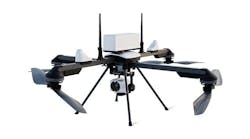Skydio and Arris Revolutionize Drone Design and Manufacturing
Skydio and Arris have redefined airframe design leveraging Additive Molding, Arris’s breakthrough carbon fiber manufacturing technology. Starting with the new Skydio X2 drone, enterprise, public sector and defense customers will benefit from lighter, longer-range, and more robust aircraft structures at scale. The collaboration has resulted in the first-of-its-kind production use of Arris’s technology in the UAV (unmanned aerial vehicle) industry, enabling some advantages:
- Advanced airframe design with component consolidation allowing Skydio to replace a 17 part assembly with a single, multi-functional structure.
- Strength and stiffness of titanium at a fraction of the weight, enabling the Skydio X2 to increase range, and speed
- Optimized carbon and glass fiber layout based on functional requirements of individual regions of the airframe
- Scalable US-based manufacturing and innovation to bring peak aerospace performance at lower cost
“We are excited about the value that our partnership with Arris will bring to our customers. At Skydio, we pursue cutting edge innovation across all facets of drone technology. The unique properties of Arris’s Additive Molding carbon fiber allows us to optimize the strength, weight, and radio signal transparency of the Skydio X2 airframe to deliver a highly reliable solution that meets the needs of demanding enterprise, public safety and defense use cases,” said Adam Bry, Skydio’s CEO.
Skydio X2 is Skydio’s latest autonomous drone solution for enterprise, public sector and defense. X2 pairs Skydio’s breakthrough autonomy software with a rugged, foldable airframe for easy “pack and go” transportation, and up to 35 minutes of flight time. The X2 airframe will include a newly designed core structural element manufactured with Arris’s Additive Molding technology. Arris’s first-of-its-kind Additive Molding leverages 3D-aligned continuous fiber composite materials for complex shapes where material composition can change within regions of a single part. As a result, Skydio has been able to use a single carbon fiber component with the structural results that would have otherwise required 17 parts.
“The evolution of aerospace design has been punctuated by breakthroughs in manufacturing and materials. Such a moment has come where manufacturing of optimized structures has converged with composite materials ideals to unlock previously impossible, high-performance aerospace designs,” said Ethan Escowitz, founder and CEO of Arris. “While we’re working with leading aerospace manufacturers to improve aircraft performance, sustainability and costs; Skydio’s culture and market have enabled an unsurpassed pace of innovation that has fast-tracked this transformation to deliver the next-generation of aerostructures. It’s simply amazing to see such a revolutionary product broadly available and flying today.”

